Just finished a whirlwind visit to New York City where I saw old friends and popped in to visit four separate historical museums. I got extremely lucky with the weather: sunny and high 70s with a nice breeze the whole time I was in town. It was a bit of an odd trip, scheduled at the last minute to send Adriana off to her month at Blue Mountain Center (where I’ve been myself twice previously—an incredible experience of generosity and support for writers) and to prevent losing about 30,000 about-to-expire miles on one of the frequent flyer programs I’m enrolled in.
Since I’m off to Berlin at the end of October for a “History From Below” conference of DIY historians, I thought I should do some extra research in New York in preparation for that confab. I’ll talk about what I saw in the order I did them in, starting with the City Museum of New York’s exhibit on “Activist New York,” then the Museum of the Chinese in America in Chinatown, then the Tenement Museum on Orchard Street in the Lower East Side, and finally the recently opened Museum of Reclaimed Urban Space in the East Village.
With all the work I’ve been doing over the years with Shaping San Francisco and our archive at Foundsf.org, I have thought a lot about how to present historical information. But I can’t honestly say I’ve settled on any particular formula that feels like it always works. Sometimes I want great depth and complexity, other times a photo essay tells the story best, and then there are times when an oral history clip, either video or audio, can really bring a story to life. Other times such clips can be weirdly trivial and uninteresting, so there’s not a sure-fire way to approach these things.
Similarly, there’s been a discussion about a Museum of the City of San Francisco going on for years now. The project as it is so far constituted is controlled by the San Francisco Museum and Historical Society (though I’ve heard rumors that they may be breaking it apart again after some five or maybe even 10 years of not succeeding as a shotgun marriage) and is projected to open someday at the Old Mint at 5th and Mission. But the SFMHS has not been able to advance the project beyond the drawing board and some elaborate but unrealized plans drawn up by well-paid consultants. Having seen the plans going back some years now, I was never very excited about what they were going to do, and definitely wondered about how well it would work, how likely it would be to engage and provoke people to think historically, or might it not be just another cable-car-and-sourdough-bread-on-the-Golden-Gate-Bridge disneyfied history?
Meanwhile, Richard Everett and Amy Hosa at the San Francisco National Maritime Museum have created a marvelous mini-museum of San Francisco history, called “The Waterfront” (free and open to the public at the Visitor Center in the corner of the Argonaut Hotel at Jefferson and Hyde), which does a fine job of telling the central story of San Francisco’s rise and development along its waterfront, which encompasses a great deal of the City’s basic economic and social history as a result. I actually wonder why we need another history museum, even though I can imagine many more historical threads to unwind in other narratives. In any case, my skepticism notwithstanding, I often find museums flat and dull and pointless, if not actively reinforcing the worst clichés and falsehoods that tend to pass for history in our amnesiac society. That I found “The Waterfront” so engaging and well-informed, informative and smart, saved the idea of museums for me, to some extent.
So in New York I went out looking at these four different institutions to see what I would learn from them, both in terms of the histories they’re presenting, but also how they’re presenting them, how they’re engaging in basic historiography. A good friend told me about the “Activist New York” exhibit after he visited it a month ago and I went hoping to find it inspiring. But something about it went flat for me soon after I started wandering through it. It’s all in one big room, divided into more than a half dozen alcoves. In each there are artifacts, huge photos on the walls, displays highlighting characters who participated in the movements being documented, and small kiosks in the middle of the floor where you can connect to current organizations still campaigning on similar issues. There was a section on women’s rights and suffrage, a section on the proletarian literature movement of the 1930s, the labor movement through the years, the gay and lesbian and transgender movement, the bicycling movement of the past few decades, the urban and architectural preservation movement (with a focus on fighting Robert Moses in NYC), and of course the Civil Rights movement and its connection to the original abolitionists; there was even a display on the “Conservative Party of New York” and its so-called activism.
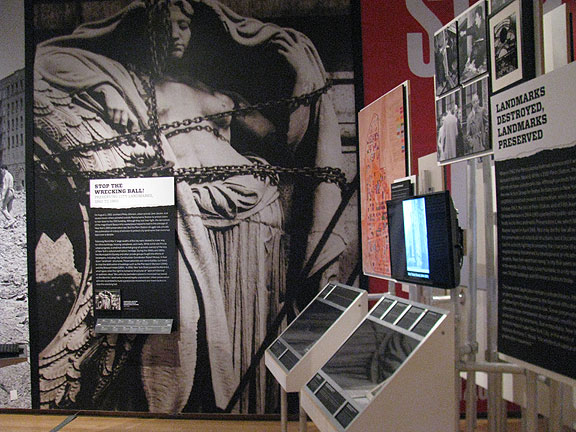
At the “Activist New York” exhibit at the City Museum of New York… from the urban preservation section.
What made this fail for me was the way the various issues were separated from one another and drained of their more compelling and interdisciplinary possibilities. For example, the bike movement was framed around the demand for bike lanes and bike safety. Of course this has been part of what some bike advocates have been arguing for, but the exhibit shows some video from “Still We Ride” and other clips of a clown posse, showing Critical Mass footage and stills as part of the experience. But you would never know that bicycling politics has radical philosophical currents that frame it around an emancipatory reinhabiting of the urban environment, or that the horizontalist logic of mass bicycling has reappeared in the Occupy Wall Street movement and elsewhere. Similarly, the gay rights section portrays the complicated legacy of LGBT activism as though it was always on a trajectory toward marriage equality as its highest goal, and discussions about the radical challenge to family life and hetero-normativity that still courses through many parts of those communities was not portrayed at all. And the idea that gay activists might engage in labor strikes, or bike rides, or bicyclists might be gay, or that campaigners for women’s rights or architectural and neighborhood preservation might also have a long background in civil rights activism, is almost denied by the way each movement is shown in its particular “silo,” perhaps concurrent, but nevertheless separate from other campaigns. So I left this exhibit feeling it had failed, and though I enjoyed many individual objects and photographs, I disliked the balkanized way it portrayed “activist” history. It fails to understand or portray the dynamic overlapping and interplay of these movements across time and space, except by stiffly presenting them all in one room together.
The rest of that gorgeous day we spent walking from 103rd Street down to see the Highline Park around 30th Street, winding our way through Central Park before emerging in midtown and wandering down 8th and 9th Avenues. Central Park was charming in such splendid weather, great views opening up of the City and the occasional 19th century bridge to stimulate a nostalgia for a long-lost world.
The Highline is a much celebrated elevated freight rail line that has been converted into a linear park after some guys who lived near it realized it had started to go “back to nature” following a couple of decades of abandonment. Slated to be torn down, they organized a campaign and now it’s not only saved, it’s a huge hit, jammed with tourists from near and far, and of course, it’s also been a boon to local property owners in the previously desolate industrial west side. The Highline is another example of a good idea (like parklets, for example) that quickly gets co-opted by developers with money into an amenity that sells their densifying highrises to a new constituency of young ostensibly “creative” professionals who like the romance of industrial decay repurposed into urban chic.
I am glad to have finally had a walk on it, and it was very pleasant. Often there are views down into the still gritty streets below that make for jarring but enjoyable juxtapositions. And the old ironworks on which it sits with the once busy railroad tracks that now harbor a variety of beautiful aromatic plants, trees, and more are also genuinely lovely. Plans are afoot to extend the park to the rest of the elevated structure, while a few dozen artists have been allowed to install a variety of projects along the way. All in all, I liked it, even though the smell of money on it and around it was awfully strong… Massive new construction is underway at both ends, the Whitney Museum building a new annex at one end, while condominium towers are slated for the other.
Rene Yung of Chinese Whispers told me to check out the Museum of the Chinese in America in New York’s Chinatown and I found it a smart and delightful place. It reminded me of “The Waterfront” in that it is a small but dense museum (designed by Maya Lin, so maybe that is part of why it works so well) that gives you the chance to go fairly deep into stories that illustrate chapters through time. They also have displays that feature audio and video, in addition to an ongoing sequence of “Hall of Fame”-like stars of Chinese American life, esp. individuals who came in the 19th century and left us with such ongoing delights as the Valencia orange and the Bing cherry. There were places where you could pull maps or drawers out of the wall and look more closely at materials, and they did a good job of capturing the pogroms of the late 19th century that drove so many Chinese out of western communities, leading to the founding of New York’s still thriving Chinatown.
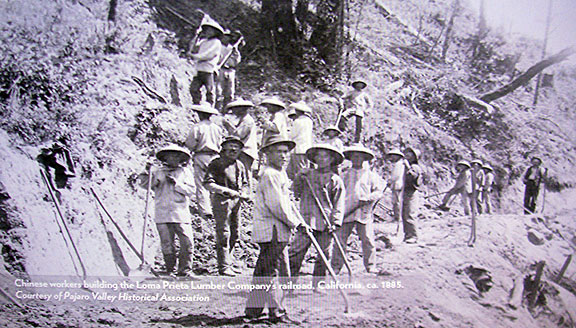
I was excited to see this image in a slideshow at the Museum of Chinese in America, showing an 1885 Chinese work crew building the Loma Prieta Lumber Company railroad into the Santa Cruz mountains.
I wondered if the Chinese museum worked where the Activist New York exhibit didn’t had to do with the framing. That is, is it easier to make a compelling, multilayered history across time by following a particular ethnic group than it is to follow multiple topics across time whose unifying quality is that they’re a form of dissent when they erupt? I felt like I’d gotten a much deeper and more complex story at the Chinese museum than I did at the City Museum’s “Activist” exhibition. Or is it because I know too much about political history and have too many opinions about it to find presentations about it nuanced enough for my taste? Whereas I don’t know the full scope of Chinese history in the U.S., so I could still find it stimulating and new (even though I do know a fair bit)? I am not sure, but I am sure that one exhibit felt really good to me and the other was disappointing.
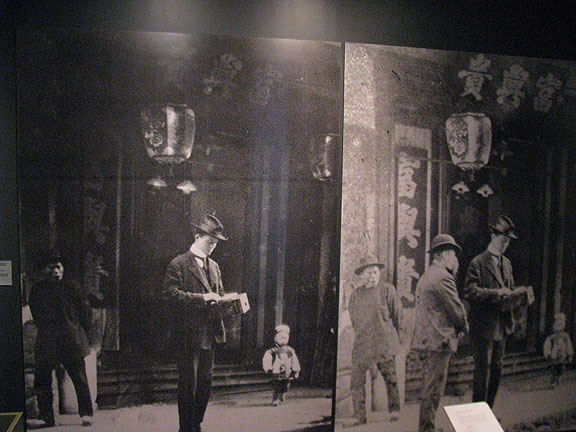
This was a great piece in their museum: An iconic Arnold Genthe image of San Francisco’s Chinatown showing how he would erase non-Chinese from his images (left) to increase the photo’s exoticism.
The next day I started out going to the Tenement Museum, another place I’d heard a lot about. It’s a fascinating story. The building was built in 1863 when the Germans were pouring into the neighborhood and it was the first foreign-language speaking neighborhood in the U.S. “Klein Deutscheland” or “Little Germany.” The builder realized he could make a lot more money by building a taller building and putting four 3-room apartments on each floor, with the toilets and a water pump in the backyard. Years later, in 1935, the owner was ordered by a new City law to make the place fireproof by taking out the wooden banisters and stairs and making other improvements and in the depths of the Depression decided it was not worth it, realizing he could make a profit from the ground floor store rents and live without the measly income from the tenants. He evicted the last remaining families (mostly Italians by then) and closed the building’s upper floors, never to open them again until some historians found it more or less intact in the late 1980s. They launched a plan for a museum, raised the money and now have a thriving nonprofit business there with separate tours to each floor and to each “story” (like the Sweatshop tour, the pub tour, and the Hard Times tour that I took; $22 for any one of them!) They also have a thriving book/gift shop and a number of employee tour guides called “educators.” The “Hard Times” tour takes you through the 2nd floor and tells the stories of two families, a German one in the 1870s and a Sicilian family that arrives in 1928 and leaves in 1935. I loved it! It’s pretty overpriced in my opinion, but the visit to the interior of the rooms and the artifacts and stories bring it all vividly to life. It’s very easy to look down Orchard Street and imagine it teeming with people when it was the most crowded district in the world around the turn of the 20th century. The Lower East Side architecture remains largely intact, mostly reclaimed from its near complete collapse in the 1970s and early 1980s, though that was also a time much honored by those who lived through it in that neighborhood for its near utopian qualities based on squatting, mutual aid, and political radicalism.
Fittingly, I ended my tour of New York history museums at my friend Bill diPaola’s new-ish “Museum of Reclaimed Urban Space”(MORUS) at 155 Avenue C in the East Village, ensconced amidst a dozen incredible community gardens within a few blocks, all keeping alive a vibrant sense of what urban life really could be. It’s a modest place in the “C-squat” building (still squatted after all these years, mostly by and for musicians), and like the whole neighborhood, went under 4 feet of water during Hurricane Sandy. The then-just opened MORUS was flooded and the new exhibits nearly wrecked, but he managed to save it all. In the basement there is the original power-generating stationary bike used at Occupy Wall Street, along with photo exhibits of Reclaim the Streets and Occupy Wall Street, an alcove dedicated to “Activist technology” (old cell phones and an explanation about txtmob which was a precursor to twitter), a whole stairway narrative about the rise of bike activism and Critical Mass in NY, leading upstairs to compelling photo exhibits of the squatter and gardening movements that were attacked so viciously during the 1990s. It’s a modest museum with virtually no financial resources, but still, it did a better job of capturing “activist New York” during the last 25 years than the very well financed exhibit at the City Museum uptown. Even better, the experience was extended into the surrounding neighborhood by a great tour that Bill gives regularly, where we visited gardens and squats. We got spontaneous presentations from garden members on composting at La Plaza Cultural, and at another garden a lengthy explanation of beekeeping in the City. It was a spectacularly beautiful Saturday afternoon so every garden was full of neighbors enjoying the shade, weeding, watering, talking, eating, making art, and just hanging out. The welcoming spirit was palpable everywhere too. Given the Museum’s title, this was the real deal, not just an exhibition of things that had happened before, but real life going on right now in genuine “reclaimed urban space!” Thus, I am giving the gold medal to MORUS, for doing by far the most with the least, but also being an institution that embodies its topic in ways that the other more professional institutions are necessarily a step or two removed from.

The “Activist Tech” corner…. shoulda mentioned the founding of Indymedia at the WTO protests in 1999 in Seattle!
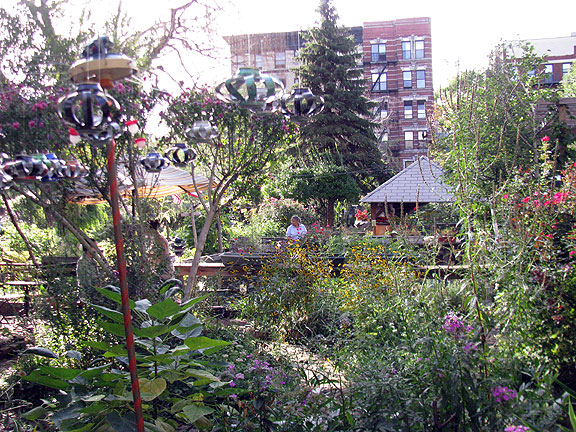
This beautiful garden is on Avenue C just across from MORUS which is in the bottom of the building at center.
It was a fascinating few days in New York, and reminded me of how much I love this city. Even as I entered on the train from the airport (came in via Newark this time) I was struck by the enormity of the public infrastructure, the density of the interdependence that makes New York possible. I suppose it’s true of all cities and all societies, but New York has a way of putting that truth in your face all at once. It was strangely reassuring!
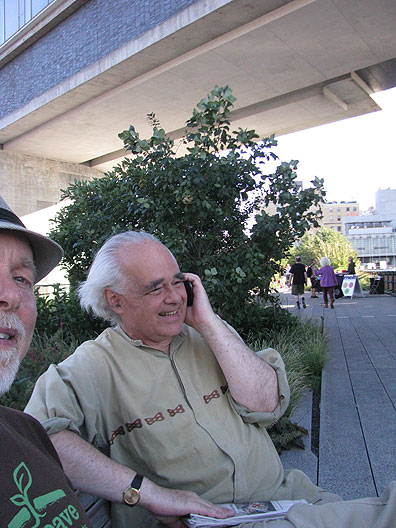
We sat down on the Highline to receive a phone call from a mutual friend in San Francisco… with Chris W.

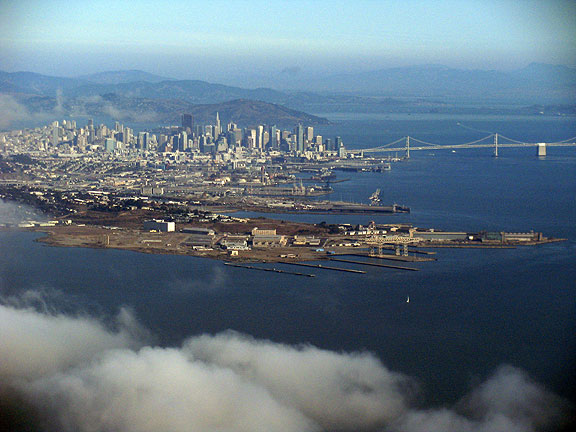

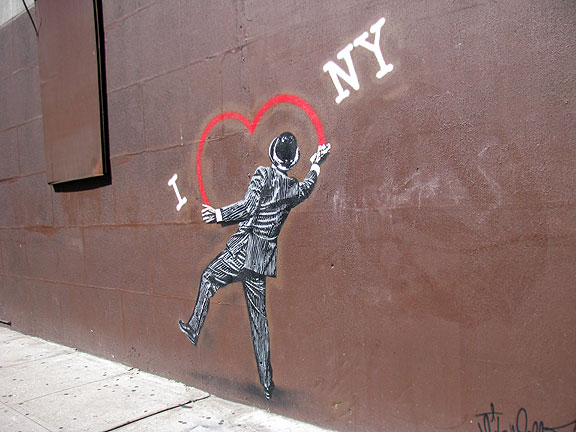
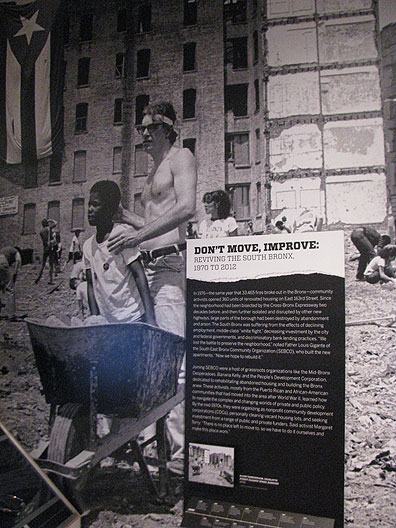
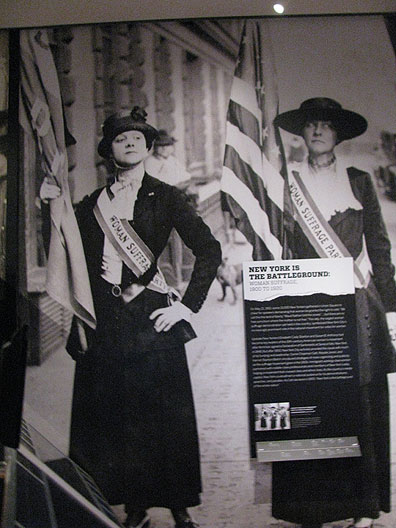

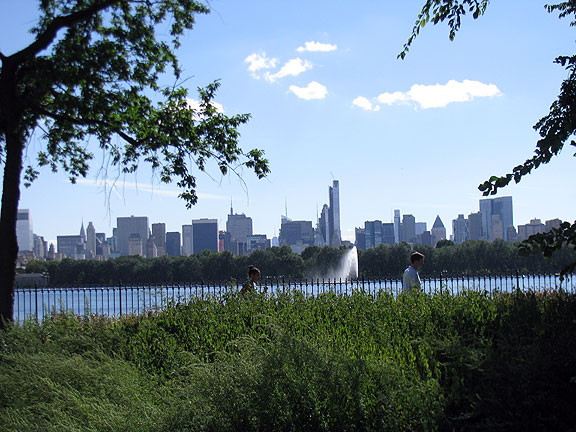
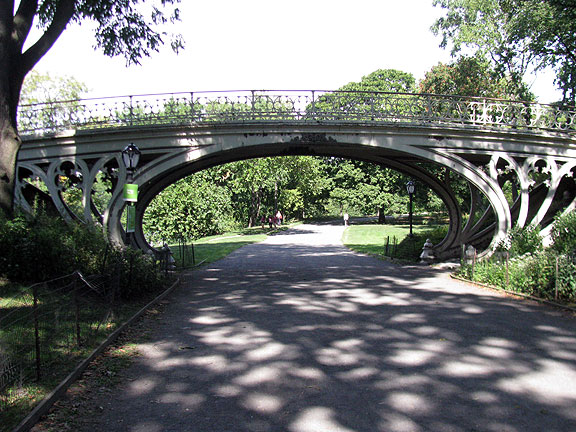

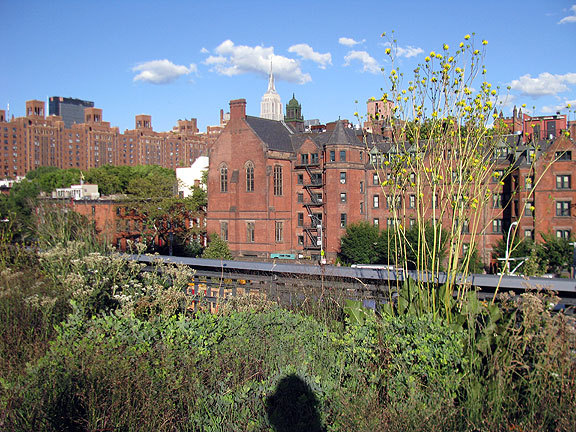
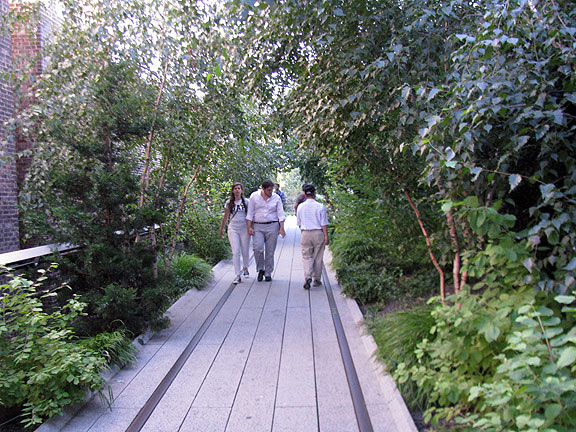
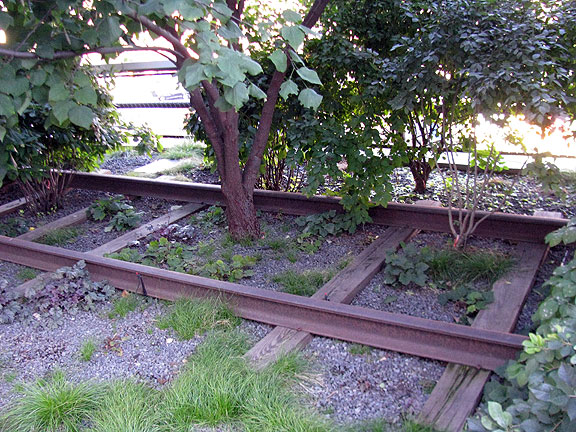
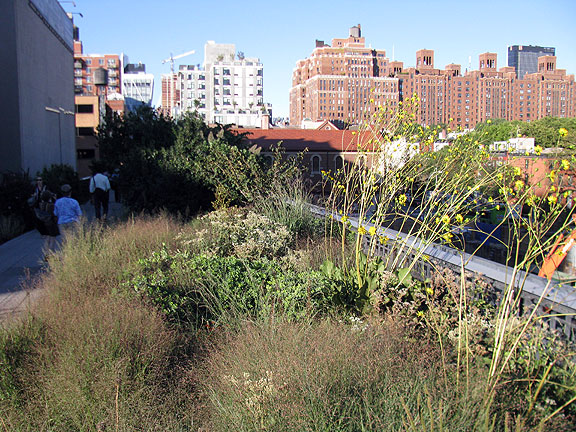
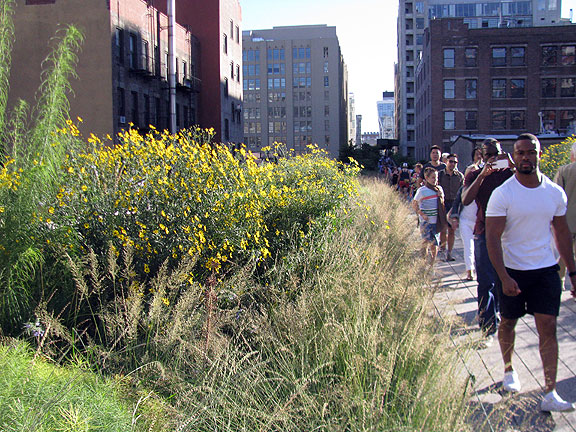
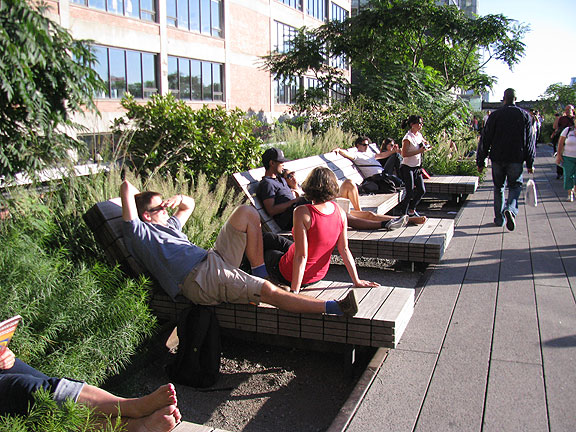

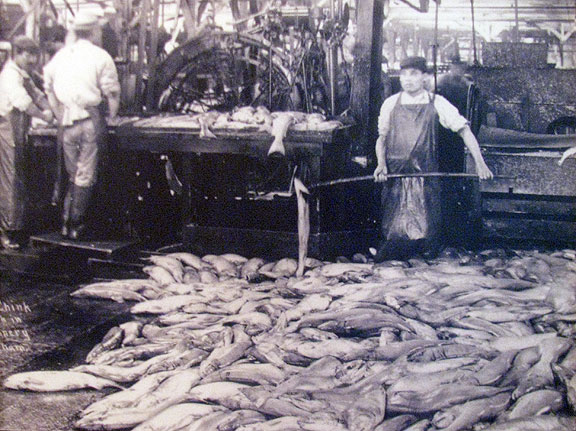
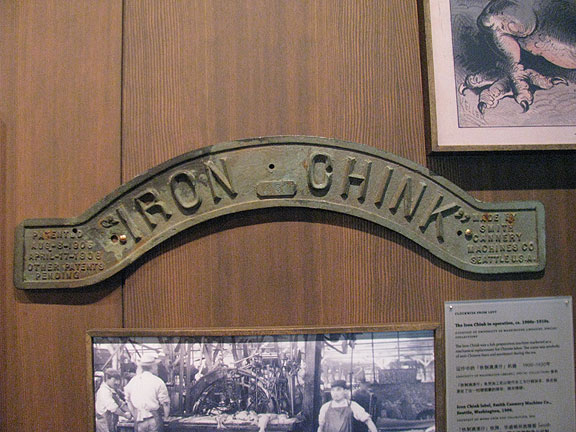
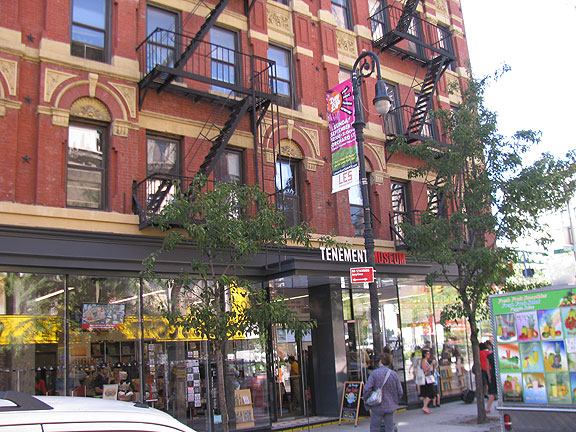
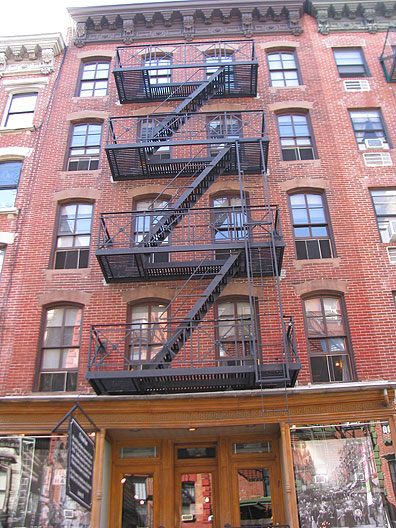
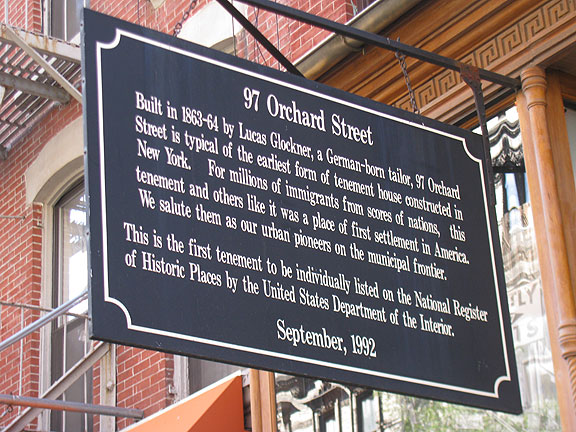
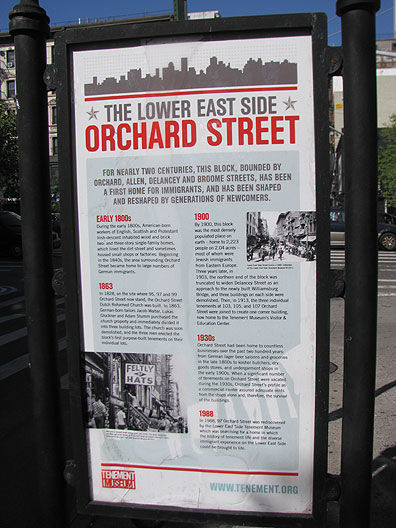

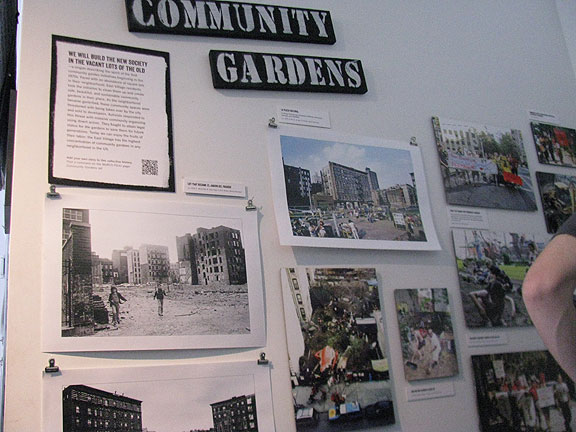
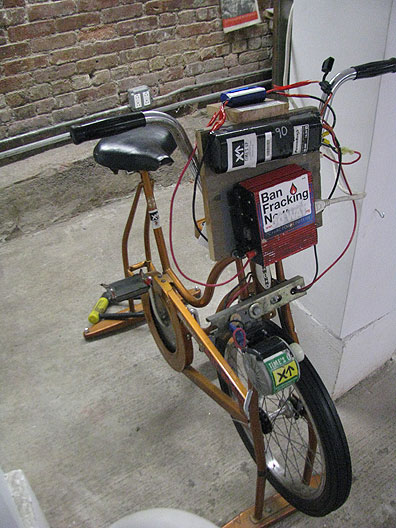


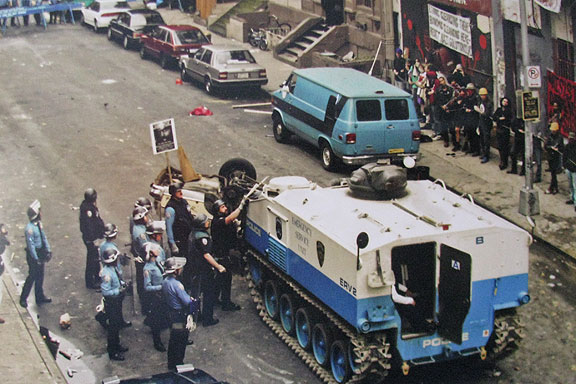
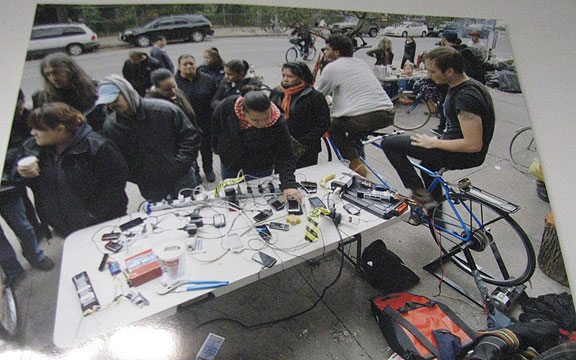
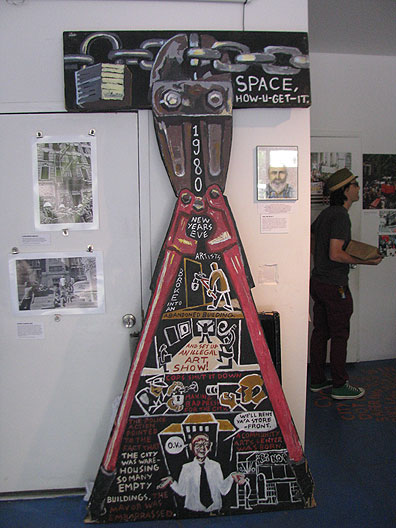
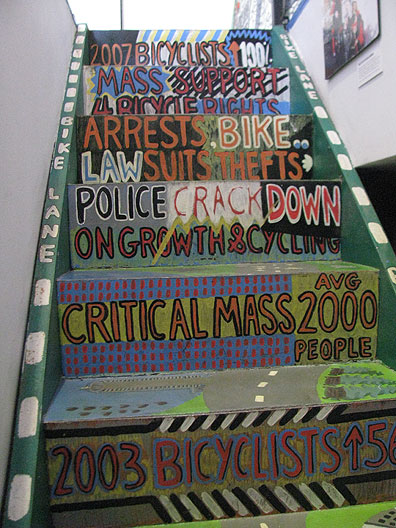

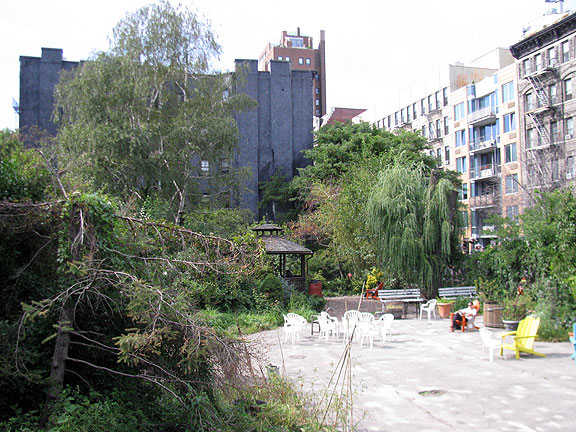
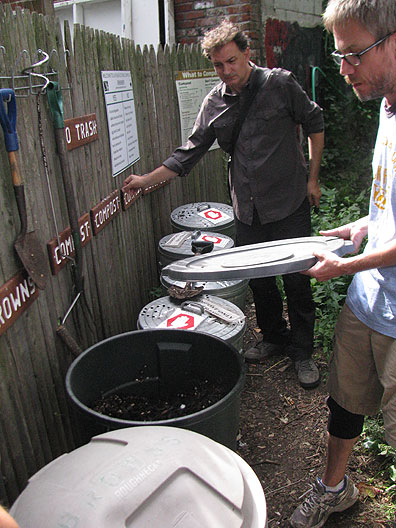
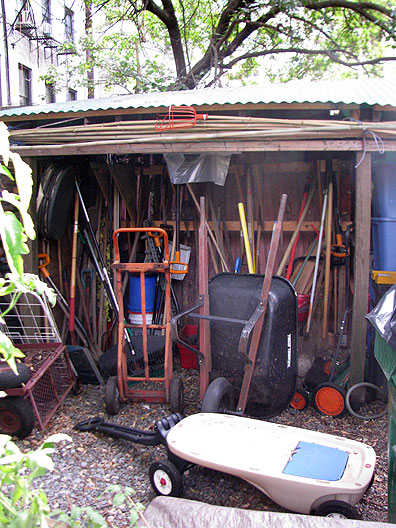
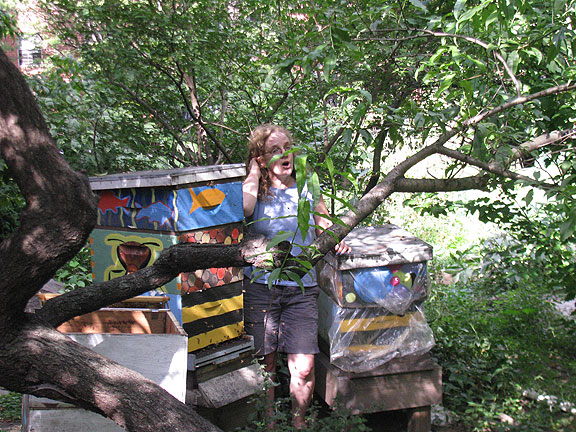
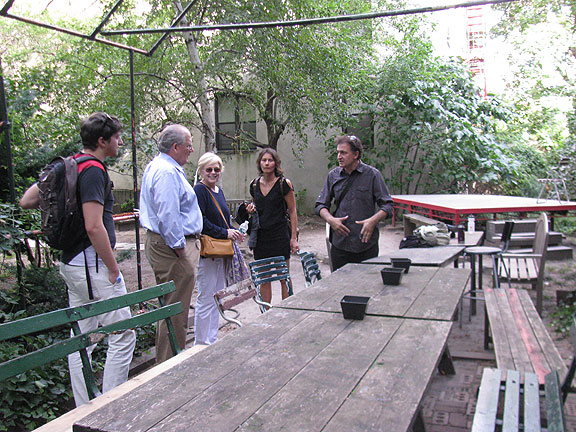
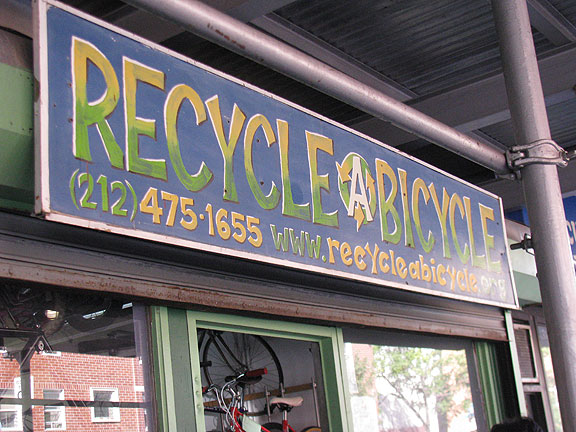
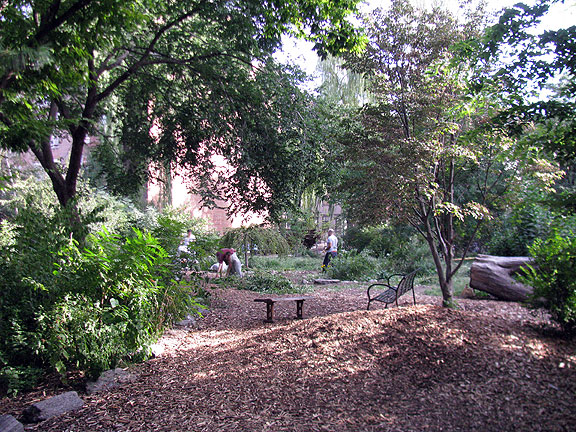
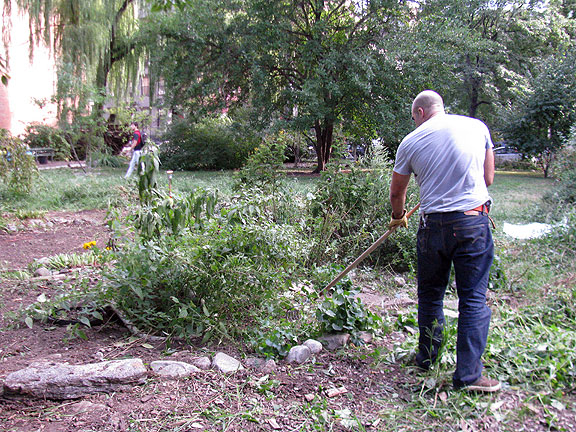
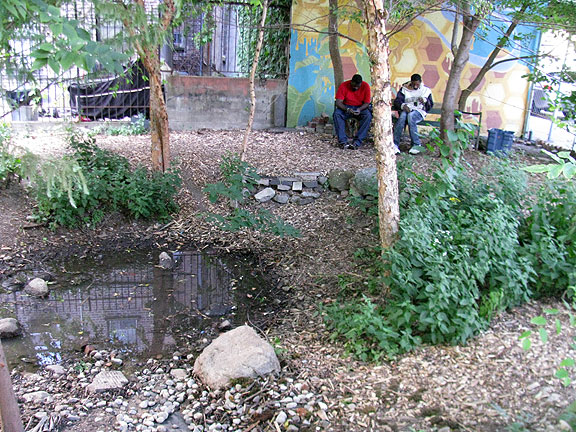
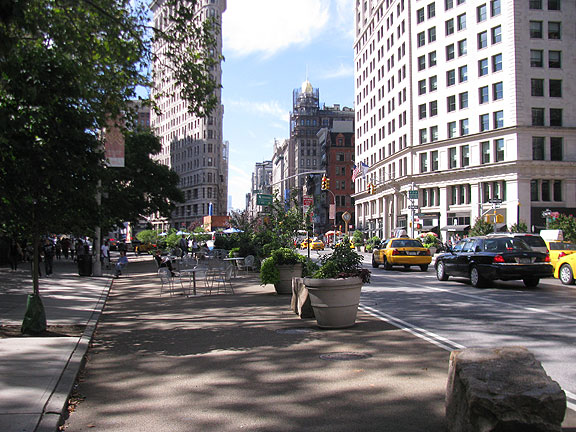











Leave a Reply